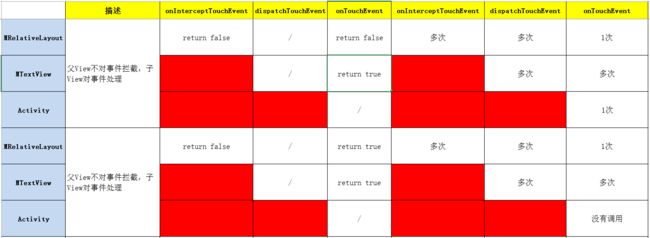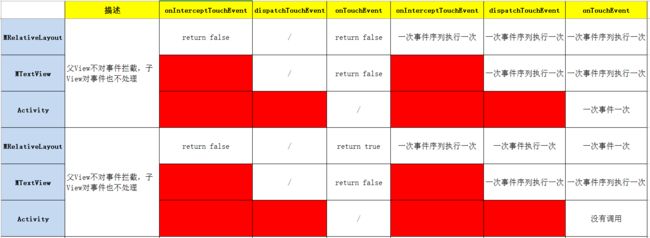1、View和ViewGroup之间的关系
在android中,ViewGroup 继承了View,也就是说android中控件全部是View,不管是TextView,Button,ImageView还是五大布局等,只不过ViewGroup可以放置其他的View和ViewGroup,而View是不可以的
2、View中的事件序列
在android中,一次操作(点击,触摸等)会产生一个事件序列,这个事件序列组成部分为:一个MotionEvent.ACTION_DOWN事件,0到多个MotionEvent.ACTION_MOVE事件,一个MotionEvent.ACTION_UP或是MotionEvent.ACTION_CANCEL事件
事件分发机制涉及的主要方法
dispatchTouchEvent(MotionEvent ev): 对事件进行分发,返回值表示是否消费当前事件,返回值受该View的OnTouchEvent()和子View的dispatchTouchEvent()方法返回值影响
onInterceptTouchEvent(MotionEvent ev): 该方法只存在于ViewGroup中,返回值表示是否对当前事件进行拦截
onTouchEvent(MotionEvent ev): 该方法返回值表示是否消费当前事件
3、详细测试
两个简单的view分别为MRelativeLayout extends RelativeLayout和MTextView extends TextView
3.1 测试一:父View对事件拦截,并在onTouchEvent()对事件处理,这个时候父view的dispatchTouchEvent返回值是为true的
3.2 测试二:父View对事件拦截,但在onTouchEvent()对事件没有处理
3.3 测试三:父View对事件不拦截,子View对事件进行处理
3.4 测试四:父view对事件不拦截,子view对事件也不处理
3.5 简要总结
public boolean dispatchTouchEvent(MotionEvent ev) {
boolean isConsume = false;
if(onInterceptTouchEvent(ev)){
isConsume = onTouchEvent(ev);
}else{
isConsume = childView.dispatchTouchEvent(ev);
}
return isConsume;
}
一个事件产生后,先由viewgroup的dispatchTouchevent对事件进行分发,dispatchTouchevent先调用onInterceptTouchEvent查看自己是否拦截了事件, 1): 如果拦截了,则再看自己的onTouchEvent对事件是否进行了消费处理,如果自己处理了,则返回true,事件到这里就结束了;如果没有处理,那么该事件则会往父view抛(onTouchEvent),如果父view都没有处理,则抛向window直到activity的onTouchEvent;2) 如果ViewGroup没有拦截事件,则交给子View的dispatchTouchEvent()来进行分发,如果子View也是ViewGroup,分发逻辑和上面一样,如果子View是一个View,那么则直接进入View的onTouchEvent()来确定事件是否被消耗掉,如果消耗了,返回true,如果没有消耗,则依次往父view抛,直到交给activity处理。
4、View源码分析
4.1 在android中,当用户触摸设备产生事件(MotionEvent)的时候,事件会先传递到activity,然后activity传给其内部的window,window再传给decorview,decorview传给布局中的相关view。
4.2 Activity.dispatchTouchEvent()
public boolean dispatchTouchEvent(MotionEvent ev) {
if (ev.getAction() == MotionEvent.ACTION_DOWN) {
onUserInteraction();// 空实现
}
// window初始化在attach()方法中
if (getWindow().superDispatchTouchEvent(ev)) {
// 事件被Activity的下级给消费掉了
return true;
}
// 事件在Activity的下级中没有被消费掉,交由Activity自己来处理
return onTouchEvent(ev);
}
4.3 Window.superDispatchTouchEvent()
Window是一个抽象类,根据Window类的注释能够知道,在整个android系统中,window只有一个子类:PhoneWindow,所以这里主要是看PhoneWindow对这个方法的实现。
@Override
public boolean superDispatchTouchEvent(MotionEvent event) {
// mDecor是一个DecorView
return mDecor.superDispatchTouchEvent(event);
}
可以看到,PhoneWindow把对事件的处理权限交给了DecorView,那么DecorView是什么呢?又是怎么初始化的呢?
4.4 DecorView
private final class DecorView extends FrameLayout implements RootViewSurfaceTaker ,
从这个定义可以看到DecorView其实就是一个FrameLayout而已。
4.5 DecorView的初始化过程
在activity中设置View是通过setContentView()方法来完成的,所以我们从这里开始分析一下是怎么操作的。
Activity.setContentView()
public void setContentView(@LayoutRes int layoutResID) {
getWindow().setContentView(layoutResID);
initWindowDecorActionBar();
}
PhoneWindow.setContentView()
@Override
public void setContentView(View view, ViewGroup.LayoutParams params) {
// Note: FEATURE_CONTENT_TRANSITIONS may be set in the process of installing the window
// decor, when theme attributes and the like are crystalized. Do not check the feature
// before this happens.
if (mContentParent == null) {
// 这里负责DecorView和mContentParent的初始化,至于mContentParent,它是:
// ViewGroup contentParent = (ViewGroup)findViewById(ID_ANDROID_CONTENT);
// ID_ANDROID_CONTENT = com.android.internal.R.id.content
installDecor();
} else if (!hasFeature(FEATURE_CONTENT_TRANSITIONS)) {
mContentParent.removeAllViews();
}
if (hasFeature(FEATURE_CONTENT_TRANSITIONS)) {// Activity过渡动画
view.setLayoutParams(params);
final Scene newScene = new Scene(mContentParent, view);
transitionTo(newScene);
} else {
// 把我们自己的布局添加到mContentParent容器中
mContentParent.addView(view, params);
}
//.........
}
PhoneWindow.installDecor()
private void installDecor() {
private void installDecor() {
if (mDecor == null) {
// 初始化DecorView
mDecor = generateDecor();
// .........
}
if (mContentParent == null) {
// 初始化ViewGroup,也就是我们定义的布局的父容器
mContentParent = generateLayout(mDecor);
// .....................
}
}
PhoneWindow.generateDecor()
protected DecorView generateDecor() {
return new DecorView(getContext(), -1);
}
PhoneWindow.generateLayout()
protected ViewGroup generateLayout(DecorView decor) {
//............
mDecor.startChanging();
// 这个名为in的View,用来决定整个window会显示成什么样子(Theme),
View in = mLayoutInflater.inflate(layoutResource, null);
decor.addView(in, new ViewGroup.LayoutParams(MATCH_PARENT, MATCH_PARENT));
mContentRoot = (ViewGroup) in;
// 从in这个view中找到我们自己定义的布局的父容器
ViewGroup contentParent = (ViewGroup)findViewById(ID_ANDROID_CONTENT);
if (contentParent == null) {
throw new RuntimeException("Window couldn't find content container view");
}
//....................
mDecor.finishChanging();
return contentParent;
}
这里贴两个名为in的View对应的布局文件
R.layout.screen_custom_title.xml
R.layout.screen_simple.xml
关于DectorView的初始化过程就是这样了,从这里也可以看出来整个View的层级关系:
Activity->window->decorview->SystemLayout->contentView->应用自定义布局对应view
4.6 继续事件分发:DecorView.superDispatchTouchEvent()
public boolean superDispatchTouchEvent(MotionEvent event) {
// 因为DecorView是一个FrameLayout,因而这里就是ViewGroup.dispatchTouchEvent()
return super.dispatchTouchEvent(event);
}
4.7 ViewGroup.dispatchTouchEvent()
@Override
public boolean dispatchTouchEvent(MotionEvent ev) {
if (mInputEventConsistencyVerifier != null) {
mInputEventConsistencyVerifier.onTouchEvent(ev, 1);
}
// If the event targets the accessibility focused view and this is it, start
// normal event dispatch. Maybe a descendant is what will handle the click.
if (ev.isTargetAccessibilityFocus() && isAccessibilityFocusedViewOrHost()) {
ev.setTargetAccessibilityFocus(false);
}
boolean handled = false;
// 是否对事件进行分发,如果窗口被遮挡,直接返回false,否则返回true
if (onFilterTouchEventForSecurity(ev)) {// 窗口没有被遮挡
final int action = ev.getAction();
final int actionMasked = action & MotionEvent.ACTION_MASK;
// Handle an initial down.
if (actionMasked == MotionEvent.ACTION_DOWN) {
// Throw away all previous state when starting a new touch gesture.
// The framework may have dropped the up or cancel event for the previous gesture
// due to an app switch, ANR, or some other state change.
// 如果监听到ACTION_DOWN事件,表明一次触摸的开始,那么一些东西就要清空和重置了。
cancelAndClearTouchTargets(ev);
resetTouchState();
}
// Check for interception.
final boolean intercepted;// 是否对事件进行了拦截
if (actionMasked == MotionEvent.ACTION_DOWN
|| mFirstTouchTarget != null) {
// mFirstTouchTarget != null这个意思是:ViewGroup本身不拦截事件,而是把事件传给子View处理了。
// 也就是说,一旦ViewGroup本身对事件进行了拦截处理,那么mFirstTouchTarget = null
final boolean disallowIntercept = (mGroupFlags & FLAG_DISALLOW_INTERCEPT) != 0;
// FLAG_DISALLOW_INTERCEPT:requestDisallowInterceptTouchEvent()中设置
if (!disallowIntercept) {// 允许对事件进行拦截处理
intercepted = onInterceptTouchEvent(ev);//
ev.setAction(action); // restore action in case it was changed
} else {// 不允许对事件拦截
intercepted = false;
}
} else {// 如果ViewGroup本身对事件进行了处理,那么ACTION_MOVE,ACTION_UP等事件就直接被ViewGroup拦截了,不会再传给子View了
// There are no touch targets and this action is not an initial down
// so this view group continues to intercept touches.
intercepted = true;
}
// 以上部分总结一下:当接收到ACTION_DOWN事件的时候,会把一些东西清空和重置
// 对于一次触摸会产生一个事件序列,如果接收到action_down事件或者事件交给了子View来处理,
// 在允许对事件进行拦截的情况下,ViewGroup的onInterceptTouchEvent()会被执行到并且只会执行到一次(ACTION_DOWN事件)。
// 所以这里要注意一点,如果ViewGroup本身对ACTION_DOWN事件进行了拦截,
// 那么对于ACTION_MOVE,ACTION_UP等事件,因为mFirstTouchTarget != null为false,
// actionMasked == MotionEvent.ACTION_DOWN || mFirstTouchTarget != null则返回false,
// 那么intercepted一直为true,因而这些事件是不会再传给子view的。
// 从这里可以看到:
// 如果ViewGroup本身对事件进行了处理,mFirstTouchTarget != null为false,那么onInterceptTouchEvent()只会被执行一次,
// 后续事件ACTION_MOVE,ACTION_UP等都不会进入 onInterceptTouchEvent();
// 而如果ViewGroup本事没有对事件进行处理,而是交给了子View来处理,
// 那么mFirstTouchTarget != null为true,则事件序列中的每个事件都会进入onInterceptTouchEvent()
// 验证测试3.3结果
// If intercepted, start normal event dispatch. Also if there is already
// a view that is handling the gesture, do normal event dispatch.
if (intercepted || mFirstTouchTarget != null) {
// ViewGroup本身对事件进行了拦截
ev.setTargetAccessibilityFocus(false);
}
// Check for cancelation.
final boolean canceled = resetCancelNextUpFlag(this)
|| actionMasked == MotionEvent.ACTION_CANCEL;
// Update list of touch targets for pointer down, if needed.
final boolean split = (mGroupFlags & FLAG_SPLIT_MOTION_EVENTS) != 0;
TouchTarget newTouchTarget = null;
boolean alreadyDispatchedToNewTouchTarget = false;
if (!canceled && !intercepted) {
// 事件没有取消也没有被ViewGroup本身拦截:事件分发给子View
// If the event is targeting accessiiblity focus we give it to the
// view that has accessibility focus and if it does not handle it
// we clear the flag and dispatch the event to all children as usual.
// We are looking up the accessibility focused host to avoid keeping
// state since these events are very rare.
View childWithAccessibilityFocus = ev.isTargetAccessibilityFocus()
? findChildWithAccessibilityFocus() : null;
if (actionMasked == MotionEvent.ACTION_DOWN
|| (split && actionMasked == MotionEvent.ACTION_POINTER_DOWN)
|| actionMasked == MotionEvent.ACTION_HOVER_MOVE) {
final int actionIndex = ev.getActionIndex(); // always 0 for down
final int idBitsToAssign = split ? 1 << ev.getPointerId(actionIndex)
: TouchTarget.ALL_POINTER_IDS;
// Clean up earlier touch targets for this pointer id in case they
// have become out of sync.
removePointersFromTouchTargets(idBitsToAssign);
final int childrenCount = mChildrenCount;
if (newTouchTarget == null && childrenCount != 0) {
final float x = ev.getX(actionIndex);
final float y = ev.getY(actionIndex);
// Find a child that can receive the event.
// Scan children from front to back.
// 对子view进行排序处理,最上层到最下层
final ArrayList preorderedList = buildOrderedChildList();
final boolean customOrder = preorderedList == null
&& isChildrenDrawingOrderEnabled();
final View[] children = mChildren;
for (int i = childrenCount - 1; i >= 0; i--) {
final int childIndex = customOrder
? getChildDrawingOrder(childrenCount, i) : i;
final View child = (preorderedList == null)
? children[childIndex] : preorderedList.get(childIndex);
// If there is a view that has accessibility focus we want it
// to get the event first and if not handled we will perform a
// normal dispatch. We may do a double iteration but this is
// safer given the timeframe.
if (childWithAccessibilityFocus != null) {
if (childWithAccessibilityFocus != child) {
continue;
}
childWithAccessibilityFocus = null;
i = childrenCount - 1;
}
// 子View不可见没有播放动画,或者触摸点不在子view上
if (!canViewReceivePointerEvents(child)// 子view既不可见或也没有播放动画
|| !isTransformedTouchPointInView(x, y, child, null)) {// 触摸点在子view外
ev.setTargetAccessibilityFocus(false);
continue;
}
// 子View正在接收touch事件
newTouchTarget = getTouchTarget(child);
if (newTouchTarget != null) {
// Child is already receiving touch within its bounds.
// Give it the new pointer in addition to the ones it is handling.
newTouchTarget.pointerIdBits |= idBitsToAssign;
break;
}
// 到这里newTouchTarget还是为null的
resetCancelNextUpFlag(child);
// 事件交由子view来处理了,这里的child是不为null的
if (dispatchTransformedTouchEvent(ev, false, child, idBitsToAssign)) {//
// Child wants to receive touch within its bounds.
mLastTouchDownTime = ev.getDownTime();
if (preorderedList != null) {
// childIndex points into presorted list, find original index
for (int j = 0; j < childrenCount; j++) {
if (children[childIndex] == mChildren[j]) {
mLastTouchDownIndex = j;
break;
}
}
} else {
mLastTouchDownIndex = childIndex;
}
mLastTouchDownX = ev.getX();
mLastTouchDownY = ev.getY();
// mFirstTouchTarget 被赋值,验证了mFirstTouchTarget!=null表示事件交由子view来消费
newTouchTarget = addTouchTarget(child, idBitsToAssign);
alreadyDispatchedToNewTouchTarget = true;
break;
}
// The accessibility focus didn't handle the event, so clear
// the flag and do a normal dispatch to all children.
ev.setTargetAccessibilityFocus(false);
}
if (preorderedList != null) preorderedList.clear();
}
// 事件交由子View来处理,但是却没有找到这样的子view
if (newTouchTarget == null && mFirstTouchTarget != null) {
// Did not find a child to receive the event.
// Assign the pointer to the least recently added target.
newTouchTarget = mFirstTouchTarget;
while (newTouchTarget.next != null) {
newTouchTarget = newTouchTarget.next;
}
newTouchTarget.pointerIdBits |= idBitsToAssign;
}
}
}
// Dispatch to touch targets.
if (mFirstTouchTarget == null) {//
// No touch targets so treat this as an ordinary view.
// 这里的child为null,因而直接执行view的dispatchTouchEvent()方法,对事件进行处理,不再传给子view
handled = dispatchTransformedTouchEvent(ev, canceled, null,
TouchTarget.ALL_POINTER_IDS);
} else {
// Dispatch to touch targets, excluding the new touch target if we already
// dispatched to it. Cancel touch targets if necessary.
TouchTarget predecessor = null;
TouchTarget target = mFirstTouchTarget;
while (target != null) {
final TouchTarget next = target.next;
if (alreadyDispatchedToNewTouchTarget && target == newTouchTarget) {
handled = true;
} else {
final boolean cancelChild = resetCancelNextUpFlag(target.child)
|| intercepted;
if (dispatchTransformedTouchEvent(ev, cancelChild,
target.child, target.pointerIdBits)) {
handled = true;
}
if (cancelChild) {
if (predecessor == null) {
mFirstTouchTarget = next;
} else {
predecessor.next = next;
}
target.recycle();
target = next;
continue;
}
}
predecessor = target;
target = next;
}
}
// Update list of touch targets for pointer up or cancel, if needed.
if (canceled
|| actionMasked == MotionEvent.ACTION_UP
|| actionMasked == MotionEvent.ACTION_HOVER_MOVE) {
resetTouchState();
} else if (split && actionMasked == MotionEvent.ACTION_POINTER_UP) {
final int actionIndex = ev.getActionIndex();
final int idBitsToRemove = 1 << ev.getPointerId(actionIndex);
removePointersFromTouchTargets(idBitsToRemove);
}
}
if (!handled && mInputEventConsistencyVerifier != null) {
mInputEventConsistencyVerifier.onUnhandledEvent(ev, 1);
}
return handled;
}
4.8 ViewGroup.dispatchTransformedTouchEvent()
/**
* Transforms a motion event into the coordinate space of a particular child view,
* filters out irrelevant pointer ids, and overrides its action if necessary.
* If child is null, assumes the MotionEvent will be sent to this ViewGroup instead.
*/
private boolean dispatchTransformedTouchEvent(MotionEvent event, boolean cancel,
View child, int desiredPointerIdBits) {
final boolean handled;
// Canceling motions is a special case. We don't need to perform any transformations
// or filtering. The important part is the action, not the contents.
final int oldAction = event.getAction();
if (cancel || oldAction == MotionEvent.ACTION_CANCEL) {// 事件取消
event.setAction(MotionEvent.ACTION_CANCEL);
if (child == null) {
handled = super.dispatchTouchEvent(event);
} else {
handled = child.dispatchTouchEvent(event);
}
event.setAction(oldAction);
return handled;
}
// Calculate the number of pointers to deliver.
final int oldPointerIdBits = event.getPointerIdBits();
final int newPointerIdBits = oldPointerIdBits & desiredPointerIdBits;
// If for some reason we ended up in an inconsistent state where it looks like we
// might produce a motion event with no pointers in it, then drop the event.
if (newPointerIdBits == 0) {
return false;
}
// If the number of pointers is the same and we don't need to perform any fancy
// irreversible transformations, then we can reuse the motion event for this
// dispatch as long as we are careful to revert any changes we make.
// Otherwise we need to make a copy.
final MotionEvent transformedEvent;
if (newPointerIdBits == oldPointerIdBits) {// 触摸点和上次一样
if (child == null || child.hasIdentityMatrix()) {
if (child == null) {
handled = super.dispatchTouchEvent(event);
} else {
final float offsetX = mScrollX - child.mLeft;
final float offsetY = mScrollY - child.mTop;
event.offsetLocation(offsetX, offsetY);
handled = child.dispatchTouchEvent(event);
event.offsetLocation(-offsetX, -offsetY);
}
return handled;
}
transformedEvent = MotionEvent.obtain(event);
} else {
transformedEvent = event.split(newPointerIdBits);
}
// Perform any necessary transformations and dispatch.
if (child == null) {// 子View不存在,则交给ViewGroup的父类View来处理了
handled = super.dispatchTouchEvent(transformedEvent);
} else {//子View存在
final float offsetX = mScrollX - child.mLeft;
final float offsetY = mScrollY - child.mTop;
transformedEvent.offsetLocation(offsetX, offsetY);
if (! child.hasIdentityMatrix()) {
transformedEvent.transform(child.getInverseMatrix());
}
// 子view dispatchTouchEvent()
handled = child.dispatchTouchEvent(transformedEvent);
}
// Done.
transformedEvent.recycle();
return handled;
}
4.8 ViewGroup.addTouchTarget()
private TouchTarget addTouchTarget(View child, int pointerIdBits) {
TouchTarget target = TouchTarget.obtain(child, pointerIdBits);
target.next = mFirstTouchTarget;
// mFirstTouchTarget 赋值了
mFirstTouchTarget = target;
return target;
}
4.9 View.dispatchTouchEvent()
public boolean dispatchTouchEvent(MotionEvent event) {
// If the event should be handled by accessibility focus first.
if (event.isTargetAccessibilityFocus()) {
// We don't have focus or no virtual descendant has it, do not handle the event.
if (!isAccessibilityFocusedViewOrHost()) {
return false;
}
// We have focus and got the event, then use normal event dispatch.
event.setTargetAccessibilityFocus(false);
}
boolean result = false;
if (mInputEventConsistencyVerifier != null) {
mInputEventConsistencyVerifier.onTouchEvent(event, 0);
}
final int actionMasked = event.getActionMasked();
if (actionMasked == MotionEvent.ACTION_DOWN) {
// Defensive cleanup for new gesture
stopNestedScroll();
}
if (onFilterTouchEventForSecurity(event)) {
//noinspection SimplifiableIfStatement
ListenerInfo li = mListenerInfo;
// 优先执行OnTouchListener.onTouch()
if (li != null && li.mOnTouchListener != null
&& (mViewFlags & ENABLED_MASK) == ENABLED
&& li.mOnTouchListener.onTouch(this, event)) {
result = true;
}
// 在OnTouchListener为null时才执行onTouchEvent
// 在onTouchEvent()中的ACTION_UP事件中判断ClickListener是否不为null,
// 如果 不为null,则执行onClick()
if (!result && onTouchEvent(event)) {
result = true;
}
}
if (!result && mInputEventConsistencyVerifier != null) {
mInputEventConsistencyVerifier.onUnhandledEvent(event, 0);
}
// Clean up after nested scrolls if this is the end of a gesture;
// also cancel it if we tried an ACTION_DOWN but we didn't want the rest
// of the gesture.
if (actionMasked == MotionEvent.ACTION_UP ||
actionMasked == MotionEvent.ACTION_CANCEL ||
(actionMasked == MotionEvent.ACTION_DOWN && !result)) {
stopNestedScroll();
}
return result;
}
以上,是View事件分发机制的基本过程,总得来说,当设备接收到事件的时候,先由activity来进行分发(dispatchTouchEvent())给window,window接收到事件的时候交给DecorView来处理,而DecorView本身是一个ViewGroup,因而存在自己拦截处理或是分发给子view来处理等几种情况,如果自己进行拦截处理(OnInterceptTouchEvent() return true),那么事件最终是否消费取决于ViewGroup.onTouchEvent(),并且事件是不会再传给子View的;如果事件交由子view来处理,那么事件是否消费则由子view来定了,这个逻辑基本和现有逻辑一致。view对于事件的处理,是直接由onTouchEvent来决定的,在View.onTouchEvent()中首先会判断是否有TouchListener,如果有,则直接执行onTouch,如果没有,则再看clickListener有没有,有,执行onClick。




